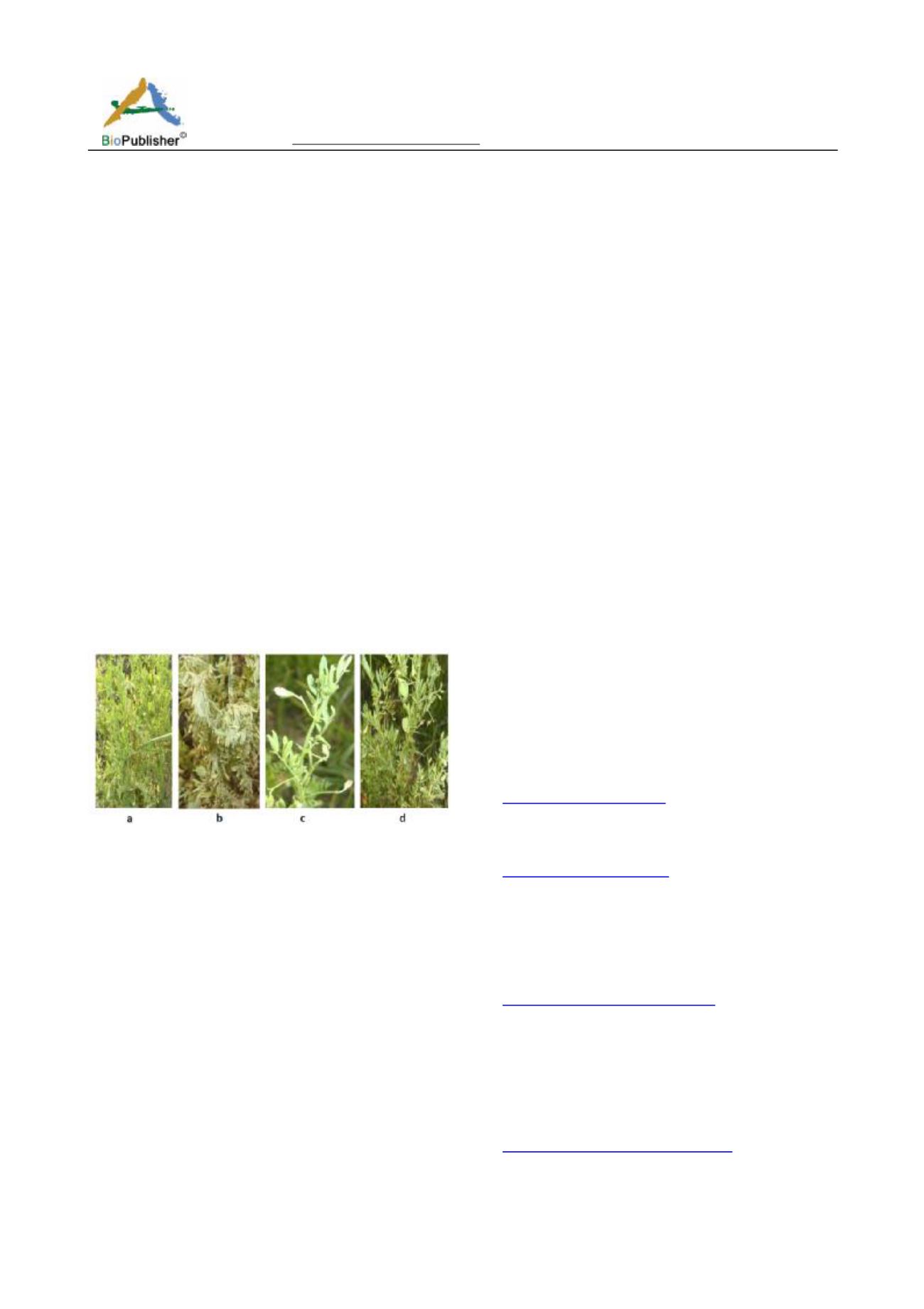
Legume Genomics and Genetics 2016, Vol.7, No.1, 1-11
10
agrometeorological observatory of the Indian Institute
Pulses, Research, Kanpur.
5.4 Data recording
Delayed sowing exposed plants to higher temperature
at reproductive phase under irrigated conditions in
field. Ten plants were selected randomly from each
single row plot in order to take observation on
individual plant. Observations were recorded visually
on formation of flowers and quantitatively on filled
and unfilled pods per plant. Moreover the top 7-8 cm
terminal branch of each individual plant was
quantitatively recorded for number of filled and
unfilled pods under high temperature (>35
o
C). The
post-harvest data was recorded on 100-seed weight (g)
for each genotype. Based on these traits, present
germplasm accessions were characterized into (i)
sensitive (i.e. plants with flowers but no or rare pods),
(ii) highly sensitive (i.e. plants with no or rare flowers
and pods), (iii) tolerant (i.e. plants with filled pods but
rare/no pods on terminal branch) and (iv) highly
tolerant (i.e. individual plans and terminal branch with
normal podding) categories (Figure 4).
Figure 4 Sensitivity of lentil plants during reproductive period
under the high temperature (a) sensitive, (b) highly sensitive,
(c) tolerant and (d) highly tolerant
5.5 Determination of pollen viability
Pollen viability of the fresh pollens was studied in
those accessions which showed tolerance on the basis
of morphological characters. It was determined by
acetocarmine technique (Robert, 1977) and those
pollen grains stained deeply and looking normal were
counted as viable and weakly stained were counted as
non-viable (Pearsonand Harney, 1984). For each
genotype, 2000 pollen grains were recorded by
counting 200 pollen grains per slide. The pollen
viability (%) was calculated using the following
formula.
Pollen viability (%) = (Number of stained pollen /
Total number pollen counted) × 100
5.6 Statistical analysis
Analyses of variance (ANOVA) were carried out for
year-wise data on various traits using the statistical
analysis tool of GENSTAT 14th edition (Payne et al.,
2011). A combined analysis of variation over years
was carried out for partitioning the phenotypic
variance into year, genotype, and error variances.
Phenotypic correlations were calculated using the
mean values over years (SAS Institute, 2007). The
critical difference (CD) at 5% significance level was
calculated by using following formula.
CD= √2 MSe/no. of years × t
5%
for error degree of
freedom
Where, MSe is the error means of square.
Acknowledgement
Thanks are due to DAC, Government of India, New Delhi and
to CGIAR program on Grain legumes for providing financial
support to carry out this study.
References
Allard R.W., 1960, Principal of plant breeding. John Wiley and Sons, Inc,
New York
Devasirvatham V., Gaur P.M., Mallikarjuna N., Tokachichu R.N.,
Trethowan R.M. and Tan D.K.Y., 2012, Effect of high temperature on
the reproductive development of chickpea genotypes under controlled
environments. Functional Plant Biololgy, 39: 1009-1018
Djanaguiraman M., Prasad P.V.V., Boyle D.L. and Schapaugh W.T., 2013,
Soybean pollen anatomy, viability and pod set under high temperature
stress, Journal of Agronomy and Crop Science, 199: 171-177
Dua R.P., 2001, Genotypic variations for low and high temperature
tolerance in gram (
Cicer arietinum
),
Indian Journal of Agricultural
Sciences, 71: 561-566
Erskine W., Sarker A., and Kumar S., 2011, Crops that feed the world 3.
Investing in lentil improvement toward a food secure world, Food
Security, 3: 127-139
Gopesh C.S., Sarker A., Chen W., Vandemark G.J., and Muehlbauer F.J.,
2013, Inheritance and linkage map positions of genes conferring
agromorphological traits in
Lens culinaris
Medik, International Journal
of Agronomy Volume 2013, Article ID 618926: 9 pages
Gross Y. and Kigel J., 1994, Differential sensitivity to high temperature
ofstages in the reproductive development in common bean (
Phaseolus
vulgaris
L.), Field Crops Research, 36: 201-212
Kalra N., Chakraborty D., Sharma A., Rai H.K., Jolly M., Cher S., Ramesh
K.P., Bhadraray S., Barman D., Mittal R.B., Lal M., and Sehgal M.,


